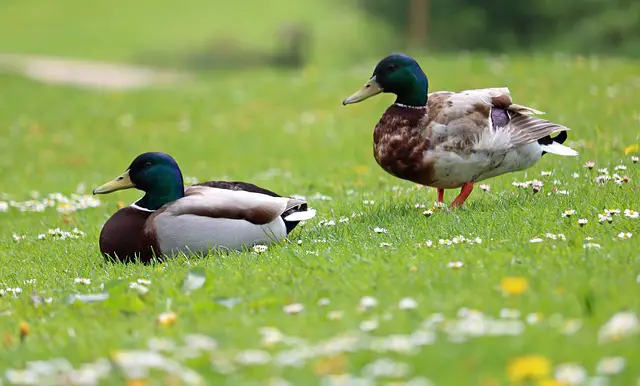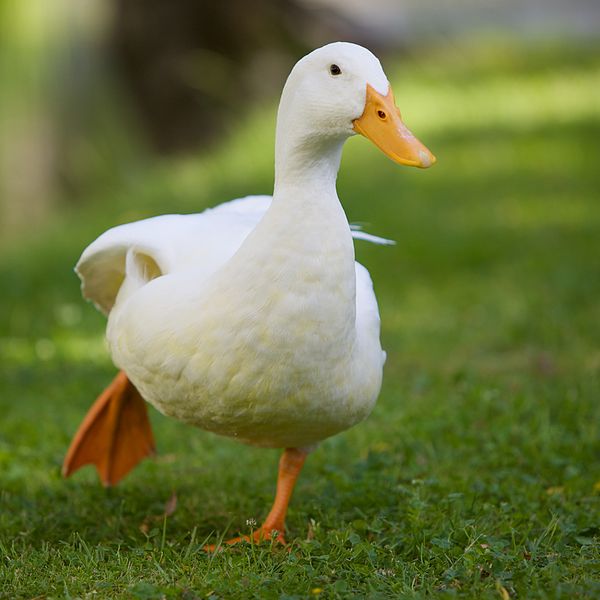
Ducks are very common of waterfowl, and everyone is familiar with them. Yet, people don’t know a lot about them.
How many different types of ducks are there?
Usually when people think about ducks, they think about the ones they have seen at the local pond. Or even just think about the most common mallard. However, there are various species of ducks. Some off them doesn’t even have the word duck in their name.
The dabbling duck is sometimes called the “dabblers”. These are the ducks that is seen nibbling along the surface of the water and which search through shallow water and mud for plant matter and insects. They hardly ever dive under the water and is well adapted to eat on land as well. Mallards, northern pintails, American wigeons and some teals are the most common dabblers.
Diving ducks are known for diving deep into the water in search of food and are agile swimmers. They feed on fish, insects and water plants. They are mostly found in water, as they prefer to stay there. They can be very ungainly and awkward on land. When they try to fly from the water, they must build up speed to be able to take off. Diving duck species include goldeneyes, scaups, canvasback and redhead.
Eider duck species have a very strange looking beak. They are a type of sea duck and are only found in the very northern parts of the world, more specifically in Arctic habitats. There habitat is extremely cold and freezer, which means they have a lush down. This lush down has extensive insulating properties, which means they are kept warm in these extreme conditions. There are only a few Eider species, which include the common, Steller’s, spectacled and the King.
Goldeneye ducks are named for their bright yellow eyes. These ducks are diving ducks and have big round heads with an iridescent sheen. They make their nest in three holes and are known for their sharp black and white plumage. There are only two types of goldeneye species, which is the common and the Barrow’s goldeneye. Sometimes buffleheads are also classified as goldeneye.
Perching ducks can be recognised by the prominent talons that they have on their webbed feet. The talons enables them to have better grip to perch. These ducks nest a few feet from the ground and can be found in trees. Perching ducks include Muscovy, pink eared, wood and mandarin ducks.
Another specie of sea ducks are Scoters. They are bulky with dark plumage and swollen, brightly coloured and patterned bills. Their body is rather plain. Scoters are most common in the northern regions, and usually nest in rocky areas and other marine habitats. Their species include surf, common, black, white-winged and velvet.
Stifftails are named after their stiff tails that looks like little spikes. These spikes are used as rudders while swimming. They are known for their colourful bills and small compact bodies. Their tales can be held at an angle for mating purposes or as a territorial display. Their species include masked duck, blue-billed duck and ruddy duck.
Teals are one of the favourite ducks for waterfowl hunters to hunt. They are a type of dabbling ducks and are brightly coloured. Teals are managed as game birds and include cinnamon, green-winged and silver teal.
Whistling ducks are tropical ducks which have distinctive long necks and legs, they are often mistaken as small geese. They have a shrill whistling call and can be heard from miles away. This sound is often confused with the sounds of other birds and animals because it travels such a vast distance. The whistling-duck species are fulvous, white-faced and black bellied.
Domestic ducks are a specie on their own and are found on farms, in gardens and zoos and ca be kept as pets. They are also the ones that are most commonly found on urban ponds. They are usually part of a mixed flock and have a wide range of sizes and colours. They can mate with other domestic birds, which results in a high degree of hybrid ducks[i].
How long do ducks live?
The live span of ducks various from specie to specie. Some teals live only 13 years, while the oldest mallard on record lived to be 27years old. The red crested duck only lives between 4 to 7 years. Domestic ducks live for about 4 years, some live longer but that is the exception rather than the rule.
Do pet ducks fly away?
Pet ducks have mostly been breed not to be able to fly. Sometimes it might look like they fly, but in fact they can jump very high. Pet ducks are usually domesticated ducks and will probably not be able to fly. If one of the wild species have been reared as a pet, they will fly away if they are migratory birds. A pet mallard will bond with its owner and will never leave. But if the duck do fly away, they will come back for occasional visits and aren’t lost forever.
What do mallard ducks eat in the winter?
Ducks are omnivorous, which enables them to eat a variety of food. During the winter months when their food sources are scarce, they will pretty much eat anything that is available. They will eat more seeds, nuts and other easy accessible foods.
How do mother ducks feed their babies?
Water ducks will feed their ducklings regurgitated food for the first 60 days, and after that the ducklings find their own food. Ducks that breed on land allow their ducklings to find their own food. Ducks do not give their ducklings milk, they do not have the mammary glands to be able to produce milk.
Can ducks eat popcorn?
Ducks can eat maize, however, it must be raw food. If the popcorn has already sprung it is not a good idea to feed it to ducks. Keep in mind that if ducks only get foods such as popcorn, it can die from malnutrition.
Can ducks eat peanuts?
Ducks are able to eat and digest peanuts. In fact some duck species eat nuts and seeds during winter to survive.
Can ducks eat grapes?
Grapes are fine to give to a duck. Once in a while. Grapes and other fruits are very high in sugar. It is a good idea to rather give them leafy greens.
Can ducks eat chocolate?
Ducks are forever looking for food. They will eat chocolate if they come across a piece. However, it can kill them. The chocolate does not possess any nutritional value for the birds and may lead to malnutrition.
When do ducks migrate?
Ducks migrate in the fall months to warmer climates. They do not migrate because it is cold, but they migrate to places that will have ample food for them. During spring they migrate back to their nesting areas.
How far do ducks migrate?
During the fall migration ducks migrate at average 875 miles and during spring they average 730miles.
Can pekin ducks live outside in the winter?
Pekin ducks can survive outside in winter, however it is always a good idea to make sure that they have a warm structure in which they can stay if it gets really cold. Always make sure that their water is not frozen, use a heated bird bath.
What is group of ducks called?
There are actually a few words that describe a group of ducks. The most common word is a flock of ducks. One of the more out dated words is a badling of ducks. Waterfowls, which include ducks, can also be called a bunch, paddling or raft as well as a plump[ii].
Difference between male and female mallard ducks
The female ducks or hens are dowdy and brown, their beaks are orange with brown on top. The male ducks or drakes have a vivid purple sash on their wings and a bright green head. During non-mating season the drakes are brownish, dull looking with a dark yellow bill. The hens are also smaller than the drakes.
Are wood ducks endangered?
Wood ducks in North America is classified as least concerned under their conservation status.
Do ducks have teeth?
Ducks do not have teeth. They use their beaks to grind food or to break it into smaller pieces if the need.
What are baby ducks called?
Baby ducks are called ducklings.
Do ducks keep snakes away?
Ducks eliminate only small snakes because they are hunters. Do not be shocked to find your duck eating a small snake.
Do pekin ducks mate for life?
Domestic ducks do not mate for life. However, ducks must feel attached to someone or something. When they are ducklings, they attach to their mother or whoever is raising them. This might make it look like they mate for life.
What are the predators of ducks?
Ducklings are easy pray for large fish, crocodiles and alligator snapping turtles. On land their nests are rated by foxes, large birds, hawks and owls. It is mostly the ducklings that are at risk for predators. Adult ducks are prey to humans and the peregrine falcon.
How often do ducks lay eggs?
Most ducks only breed once a year.
What is the gestation period for ducks?
The incubation period for ducks varies from specie to specie. Pekin ducks have an incubation period of 28days, while Muschovy ducks have an incubation period of 35 – 37 days.
How long do white ducks live?
The life span of a normal white pekin duck is between 4 to 7 years.
How to care for baby ducks?
Ducklings must have access to nutritional food as well as someone that they can attach to. For the first 14 days, they must not be allowed to swim. After that they can still drown. It is a good idea to keep an eye on them when they are in the pond. Ducklings can pick up their own food, just make sure that it is easy accessible.
Why do ducks live in ponds?
Ducks are waterfowl. They find their food such as frogs in water. They can survive on land, but it is risk for them. Some ducks, such as the perching ducks, can live on land without any issues. The water allows them to regulate their body temperature, have access to nutritional food and water as well as mate. Their physical built does not allow them to be agile on land, in fact they look very uncomfortable when they are on land.
Ducks are fascinating creators, and make great pets. Just remember that they are birds and will need different care from other animals.












Leave a Reply